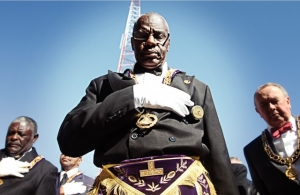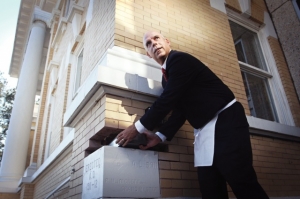Masons join to open 1911 cornerstone time capsule
By Kelly Corbett
Published in News on November 20, 2011 1:50 AM

News-Argus/MICHAEL BETTS
Senior Grand Master Mason Jackie Robinson, foreground, pauses for prayer during Friday's cornerstone ceremony.

News-Argus/MICHAEL BETTS
Brian Bullard, a Master Mason in the St. John's Lodge No. 13 A.F. & A.M., places the Duplin County time capsule into the cornerstone of the Duplin County Courthouse.
KENANSVILLE -- Two Duplin County Masonic Lodges joined forces Friday to take a trip back in time and to make history.
The Grand Lodge of North Carolina, Ancient, Free and Accepted Masons and the Prince Hall Grand Lodge, Free and Accepted Masons held a ceremony to mark the opening of a time capsule located in a cornerstone laid when the Duplin County Courthouse was built in Nov. 17, 1911.
Forty-six Masons dressed in decorative purple and gold aprons formed a procession two blocks away from the courthouse and made their way to an upstairs courtroom to open the historical marker.
"History has truly been made this day. It is my understanding that today is the first day that black and white Masons have come together for a common cause in Duplin County," said Frances Parks, chairman of the Duplin County Board of Commissioners.
She told the history of how the courthouse came to be 100 years ago, including that the original building proposal was for $30,000.
"I don't think $30,000 would re-carpet the courthouse today," said Brian Bullard, master of St. John's Lodge No. 13.
Jane Johnson took off time from work to attend the ceremony. She was born in and has lived in Duplin County for most of her life. She said she is simply interested in history.
"I just wanted to see what was in the time capsule, " she said. "Because the next 100 years, I sure won't be here."
She looked at pictures in the pamphlet that displayed the items found inside the capsule, many of them too fragile to display, which was handed out to those who attended the ceremony, and noted how times have changed.
"They sure don't dress like that now, do they?" she said.
Various speakers participated in the ceremony, sharing the history of county officials, including the clerks of superior court, the registers of deeds, the sheriffs and the district court divisions.
The current Duplin County Register of Deeds, Davis Brinson, said the Duplin County Register Deed's office is one of the oldest in North Carolina. It was created in 1665.
"We have never suffered a loss of our records, due to fire and other structural damages," he said.
Sheriff Blake Wallace said over the last 100 years, there have been nine sheriffs, five of them Masons.
Keynote speaker Charles Ingram, 146th Grand Master of St. John's Lodge, was overcome with emotion when he began his speech after hearing detailed accounts of past stories from previous speakers.
His speech focused on the past, and the future.
"We simply cannot imagine what life will be like 100 years from now," he said. "Our ancestors could not have imagined the space shuttle, and trips to the moon, and the great airplanes of today."
The end of the ceremony served as the time to reveal the 37 items of the original cornerstone in a slideshow presentation. Many of the items were destroyed from water leaking into the cornerstone, but the Nov. 23, 1911, issue of the East Carolina News listed the original items along with the name of who placed the item in the cornerstone. The items included numerous postcards, a calendar, old newspapers, a Bible, three minie balls and 11 coins.
The largest coin, a half-cent, was the oldest item in the cornerstone, dating back to 1808.
Officials removed the paper items from the cornerstone, since many were worn or damaged, but they placed the metallic items back in the capsule and added new items from 2011. Now 48 items are contained in the cornerstone in a stainless steel box, including a calendar, coins, papers, a welcome guide, a phonebook, a list of elected officials, signed business cards and two Masonic lapel pins.
The capsule was not the only historic happening that day.
Ingram said the uniting of the black and white Masons for the occasion was historic in itself.
He said the "so-called "white" Freemasonry has existed in North Carolina since at least the 1740s. So-called "black" Freemasonry has existed in North Carolina since at least 1866, shortly after the Civil War. For all of that time, until only very recently, both organizations existed independently, neither one recognizing the other as legitimate Freemasonry.
The acknowledgement was important because being able to trace Masonic heritage, or lineage, back to the Grand Lodge of England is important to Masons, but the groups overcame those barriers formally in 2008.
After the items were placed back in the capsule, the united Masons led a procession back to the site to relay the cornerstone.
Clifton W. Everett Jr., grand treasurer of the Grand Lodge of North Carolina from Greenville said it was great to be a part of the ceremony.
It "illustrates the solidarity of our government and our fraternity, which formally consisted of the Founding Fathers, who were mostly Masons," he said. "Not only this courthouse, but many other courthouses in North Carolina have Masonic cornerstones. We are following an old, ancient ceremony that's been passed down through the centuries."
He said he thinks it is important that people recognize the work Masons do, since they do a lot for the community.
Many members of the community attended the ceremony in recognition of the Masons and the courthouse.
